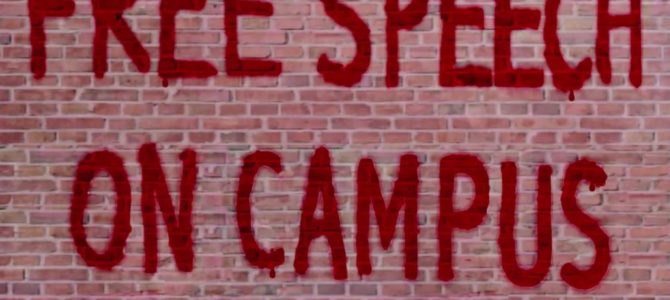
As students return to campuses across the country, it is nice to know that there are a few liberal professors remaining.
American liberals are an endangered species being pushed out of their native habitat by the more aggressive leftists, but they are not yet extinct. Evidence for their persistence is provided by Erwin Chemerinsky and Howard Gillman’s Free Speech on Campus, recently released in a new paperback edition by Yale University Press. Conservatives will have criticisms of the book (see below), but the authors really are old-school liberals who believe in free speech, in contrast to the censorious leftism that has become increasingly powerful, especially on campus.
Thus, despite the provocations and violent protests that occurred in the months since the authors completed their original manuscript, they stand by their commitment to free speech, writing that “the expression of opinion should not be censored or punished, especially on college campuses.” Restricting freedom of speech cannot be justified, even though some opinions are loathsome and hateful, some speakers provocative, and some security expensive. Mob violence cannot be allowed to veto free speech.
Although Chemerinsky and Gillman focus on campus controversies, their views derive from a general appreciation for the freedom of speech. They offer three simple reasons for the importance of protecting free speech: “Freedom of speech is essential to freedom of thought; it is essential to democratic self-government; and the alternative—government censorship and control of ideas—has always led to disaster.”
Both Kinds of Opinion
The first of these—the importance of free speech to free thought—is particularly relevant to higher education. So why are students, professors, and administrators abandoning it? The authors charitably attribute the antipathy toward free speech on campus to a “desire to protect the learning experience of all students.” Bullying and bigotry impede their victims’ educations, therefore campus authorities should stamp out hateful speech and ideas—and if they do not act, students should.
While the authors are solicitous for the welfare of those they see as belonging to marginalized groups, they do not allow this sympathy to compromise their commitment to free speech. They write that “campuses must not treat the expression of ideas as a threat to the learning environment. Freedom of expression and academic freedom are at the very core of the mission of colleges and universities, and limiting the expression of ideas would undermine the very learning environment that is central to higher education.”
They also believe their students’ desire to police speech arises in large part from ignorance. The authors claim their students have little knowledge of the history of free speech and its importance to those “vulnerable political minorities” that they claim to be most sympathetic toward. Without general protection for free speech, the marginalized and oppressed will be protected only as clients of the really powerful.
As one would expect from a book written by a law professor and a law school dean, there is a heavy reliance on legal history. The book provides a brief but sound legal history of free speech, including a discussion of speech that the First Amendment does not protect, such as true threats or the disruption of “classes or other campus activities.”
Shouting a speaker down, or occupying campus buildings, are rightly not protected by the First Amendment, and as they observe, “colleges and universities actually must impose extensive regulation on speech in professional settings.” For example, a biochemistry professor who spends his lectures ranting about politics can be legitimately disciplined for not doing his job.
These professional standards are necessary, but are also easily abused. Too often, professionalism and academic excellence are used as proxies for ideological agreement. The most significant threats to freedom of inquiry on campus are not student mobs and campus tribunals, but the admissions office, the hiring and tenure committees, and the constant pressure to conform to the campus dogmas the authors applaud. Despite warning about the dangers of groupthink, the authors seem unaware of how monolithic campuses have become.
After all, modern universities have both kinds of opinion: liberal and leftist.
Compassion Versus Indoctrination
Nonetheless, we should be grateful for principled liberals willing to stand up for our free speech rights, and we should likewise defend the rights even of obnoxious left-wing professors posting on Twitter or such. And in fairness, a slim, easy-reading volume like this cannot be expected to answer all the questions it raises. Indeed, because it was written by liberals for liberals (and for persuadable leftists), conservatives and other campus nonconformists should expect to find many of our concerns ignored.
Notwithstanding my relief at seeing some liberals still defending free speech, there are points that must be addressed, especially because this book’s omissions indicate where the liberal case for free speech is weakest, and why it has become so vulnerable to leftist attacks.
Perhaps the most irksome is the authors’ effusive praise of campus censors. They attribute opposition to free speech to “a strong and persistent urge to protect others” from hate and bullying. They write that would-be campus censors are motivated by a “laudable compassion” and that “the advocates of restricting hate speech were motivated by the best intentions.” This charitable view of the enemies of free speech might be palatable if it were generally applied, but it is not.
In contrast to this generous estimate of the motives of leftist censors, the authors repeatedly use the pejorative “indoctrination” when referencing traditional campus educational aims. They have little patience or respect for private religious schools that place some restrictions on speech, writing that “Freedom of expression should therefore be the same at all institutions of higher education.”
In their view, religious schools, especially Christian ones, restrict speech in order to indoctrinate, whereas campus social justice mobs and censorious administrators restrict speech in a compassionate effort to protect the vulnerable. This double-standard is confirmed by their endorsement of the dreadful Christian Legal Society v. Martinez decision in which the Supreme Court gutted the right to freedom of association. This decision leaves Christian student groups open to sabotage and hostile takeovers, or else forces them off campus. Concern for campus minorities vanishes when the minorities are Christians with orthodox views on human sexuality and the sexes.
Teaching Authority
This reality of power on campus is why leftists are unmoved by appeals to the necessity of preserving free speech for the oppressed and marginalized. They wield power, and they mean to use it to protect their friends and hurt their enemies. By marginalizing and oppressing those they see as wicked, they attempt to elevate those they view as the unjustly marginalized. As they see it, if you have the whip hand, start whipping. They are unconcerned that this precedent will someday be used against them. And they lack the humility to recognize that they could be wrong.
Chemerinsky and Gillman are enthusiastic about the “transformation of colleges from places of religious instruction to institutions that value and protect rigorous free inquiry.” But they overestimate both the “respect and importance” given to colleges and universities and the extent to which they have “fully embraced a culture of unfettered scholarly inquiry.” Much of higher education is justly dismissed as ideologically stifling and conformist.
The authors are blind to this because they do not grapple with the truth that intellectual inquiry can only take place within a tradition of inquiry, and that teaching authority is a necessary part of such traditions. There is no universal neutral ground from which inquiry can begin. Thus, what the authors take to be an inclusive culture of open inquiry is, in fact, deeply ideological and exclusive. So, unlike the religious schools they disdain, they are unaware of the dogmatic nature of their presuppositions, or of how unfree campus intellectual inquiry often is.
Still, this book’s defense of free speech is welcome at a time much of the left has turned against it—even if protecting free speech is no more than the Constitution requires of public institutions. But in the end, the authors’ endorsement of leftist doctrines makes their idea of a free speech campus into something like a left-wing confessional university with tolerance for the occasional dissenter. It is the college version of nineteenth-century England and the established church. For campus non-conformists, this is preferable to the leftist alternative, but it is no Arcadia of free speech and inquiry.









